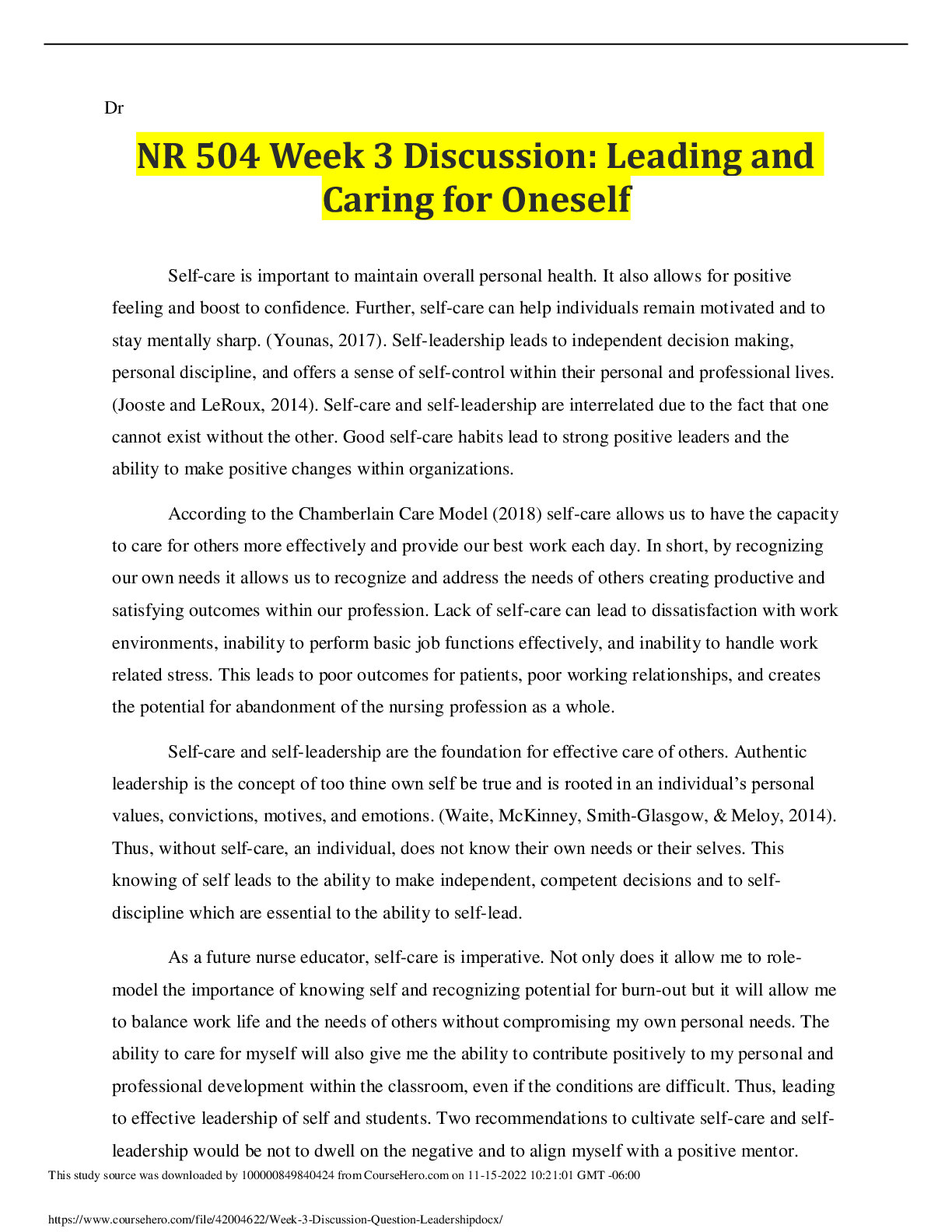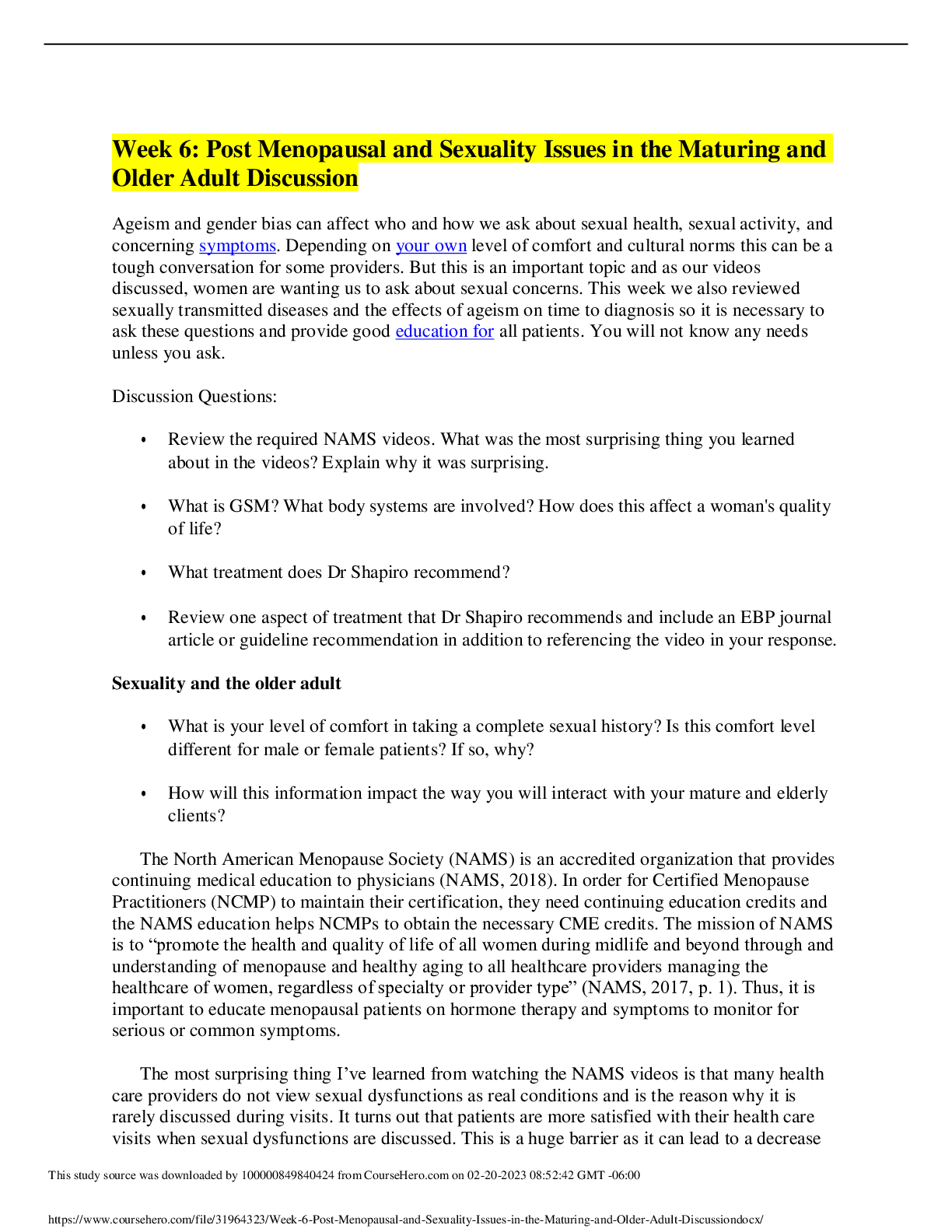*NURSING > DISCUSSION POST > NR-566 Week 2 Respiratory Treatments Discussion: Tuberclosis PLUS WEEK 2 QUIZ (100% CORRECT) | Alrea (All)
NR-566 Week 2 Respiratory Treatments Discussion: Tuberclosis PLUS WEEK 2 QUIZ (100% CORRECT) | Already GRADED A
Document Content and Description Below
NR-566 Week 2 Respiratory Treatments Discussion: Tuberclosis Week 2 Discussion Nice overview of COPD management! Although not used as often in the past, can you tell us about theophylline uses, i... ts MOA and side effects, and monitoring (from the text)? Thanks! Thank you very much, Theophylline, a xanthine bronchodilator, is available for use as a controller agent but is rarely used due to the limited data supporting its effectiveness (Muhrer, 2018). The guidelines recommend that long- acting beta2 agonists (in combination with inhaled corticosteroids) be tried before theophylline for the reason that toxicity issues may occur with theophylline (Woo & Robinson, 2016). Theophylline is not recommended for first-line therapy in COPD patients. However, if the patient has been stable on theophylline, there is no reason to discontinue the medication as long as serum theophylline levels are monitored (Woo & Robinson, 2016). Also, theophylline is set aside for the use of the long-term control of asthma and as an option but not the preferred alternative therapy in step 2 of asthma care using theophylline as an alternative treatment in combination with inhaled corticosteroids (Woo & Robinson, 2016). For children, it is indicated for the management of asthma suggesting theophylline as an alternative therapy in moderate persistent asthma, in combination with low-dose inhaled corticosteroid in children aged five years or older (Woo & Robinson, 2016). Theophylline exerts two distinct actions in the lungs; bronchodilation through smooth muscle relaxation and airway stimuli suppression (IBM Micromedex, 2020). The true mechanism of action has not been fully explained; however, bronchodilation is facilitated by inhibition of two isoenzymes, phosphodiesterase (PDE III) and PDE IV, while non-bronchodilation effects are mediated through other molecular mechanisms (IBM Micromedex, 2020). Theophylline also increases the force of contraction of diaphragmatic muscles by enhancing calcium uptake through adenosine-mediated channels (IBM Micromedex, 2020). Theophylline operates directly by an unknown mechanism mediated by selective inhibition of specific phosphodiesterase (Woo & Robinson, 2016). As a result, an increase in cAMP production leads to bronchial smooth muscle and pulmonary vessel relaxation. Theophylline is a powerful CNS stimulant, often causing insomnia and excitability, and has a greater effect on the cardiovascular system. Theophylline directly stimulates the myocardium and increases myocardial contractility and heart rate. By relaxing vascular smooth muscle, theophylline dilates the coronary, pulmonary, and systemic blood vessels. Theophylline also increases gastric acid secretion and may produce nausea and vomiting, although this reaction is probably due to CNS effects. Both methylxanthines stimulate skeletal muscle, causing tremors. Theophylline also acts directly on the renal tubules to cause increased sodium and chloride excretion. By increasing renal blood flow (from increased heart rate) and the glomerular filtration rate, theophylline also causes diuresis. These effects occur even when theophylline is within the therapeutic range (Woo & Robinson, 2016). Adverse drug reactions are uncommon with serum theophylline levels below 20 mcg/mL, although some patients may show toxic effects between 15 and 20 mcg/mL, especially during therapy initiation. The CNS adverse effects that may be seen include irritability, restlessness, seizures, and insomnia. Gastroesophageal reflux may also occur (Woo & Robinson, 2016). The cardiovascular adverse effects that may occur include palpitations, tachycardia, hypotension, and life-threatening arrhythmias. Other adverse effects include rash, diuresis, and tachypnea (Woo & Robinson, 2016). At serum theophylline levels above 20 mcg/mL, patients may experience nausea, vomiting, diarrhea, headache, insomnia, and irritability. At levels above 35 mcg/mL, the patient may have hyperglycemia, hypotension, cardiac arrhythmias, tachycardia, seizures, brain damage, and death. Monitoring for serum theophylline levels is the same in children as adults, with a steady-state theophylline level of 5 to 15 mcg/mL as the therapeutic goal. Theophylline is not recommended for use in children with asthma younger than age five because of altered metabolism during viral or febrile illnesses affecting serum concentration (Woo & Robinson, 2016). References: IBM Micromedex (2020). Mechanism of Action of Theophylline. https://www-micromedexsolutions- com.chamberlainuniversity.idm.oclc.org/micromedex2/librarian/CS/B944C8/ND_PR/evidencexpert/ND_ P/evidencexpert/DUPLICATIONSHIELDSYNC/AEF66D/ND_PG/evidencexpert/ND_B/evidencexpert/ND_Ap pProduct/evidencexpert/ND_T/evidencexpert/PFActionId/evidencexpert.DoIntegratedSearch? SearchTerm=Theophylline&fromInterSaltBase=true&false=null&false=null&=null# Muhrer, J. C. (2018). Update on diagnosis and management of severe asthma. The Journal for Nurse Practitioners, 14(7), 520–525. https://doi.org/10.1016/j.nurpra.2018.04.003 Woo, T.M. & Robinson, M.V. (2016). Pharmacotherapeutics for Advanced Practice Nurse Prescribers (4th ed.). F.A. Davis Company. Week 2 Quiz Lila is 24 weeks pregnant and has been diagnosed with tuberculosis (TB). In addition to isoniazid (INH) and rifampin (Rifidin), treatment should include which of the following? Kanamycin (Kantrex). Streptomycin. Correct! Pyridoxine (Vitamin B6). Levofloxacin (Levaquin). Question 2 1 / 1 pts Which one of the following is considered the first-line drug choice for a previously healthy adult patient diagnosed with community-acquired pneumonia? Correct! Azithromycin (Zithromax). Amoxicillin (Amoxil). Amoxicillin (Amoxil) + Doxycycline (Vibramycin) . Ciprofloxacin (Cipro). Question 3 1 / 1 pts Drug resistant tuberculosis (TB) is defined as TB that is resistant to which of the following? Amoxicillin. Fluoroquinolones. Ceftriaxone. Correct! Rifampin and isoniazid. Question 4 1 / 1 pts When a patient is prescribed nicotine nasal spray for tobacco cessation, instructions should include which of the following? Correct! The dose is one to two sprays in each nostril per hour, not to exceed 40 sprays per day. If they have a sensation of "head rush" this indicates the medication is working well. Nicotine spray may be used for up to 12 continuous months. Inhale deeply with each dose to ensure deposition in the lungs. Question 5 1 / 1 pts Digoxin levels need to be monitored closely when which of the following medications is started? Diphenhydramine. Correct! Albuterol. Ipratropium. Loratadine. Question 6 1 / 1 pts Instructions for a patient who is starting nicotine replacement therapy include which of the following? Correct! Nicotine replacement will help with the withdrawal cravings associated with quitting tobacco. Smoke less than 10 cigarettes a day when starting nicotine replacement. Nicotine replacement can be used indefinitely. Nicotine replacement therapy is generally safe for all patients. Question 7 1 / 1 pts Which of the following is a risk factor for a fatal asthma attack? A person who is on daily inhaled corticosteroid therapy. Correct! A history of requiring intubation or ICU admission for asthma. A person with moderate persistent asthma. A patient that is pregnant. Question 8 0 / 1 pts James is a 52-year-old overweight smoker taking theophylline for his persistent asthma. He tells his provider he is going to start the Atkin's diet for weight loss. Which one of the following actions should be taken next by the Nurse Practitioner? Recommend that he see a bariatric surgeon instead of dieting. You Answered Decrease his theophylline dose because a high-protein diet may lead to elevated theophylline levels. Advise the patient to stop taking the medication. Correct Answer Advise the patient that he will need regular testing of serum theophylline levels during his diet, due to increased excretion of theophylline. Smoking and high-protein diets can increase the theophylline excretion rate, and high-carbohydrate diets can decrease it. Question 9 1 / 1 pts Prior to developing a plan for the treatment of asthma, the patient's asthma should be classified according to the NHLBI Expert Panel 3 guidelines. In adults, mild-persistent asthma is classified as which one of the following? Symptoms that occur less than twice per week but without symptoms between exacerbations; PEF is greater than 80% of predicted; nighttime symptoms are less than twice per month. Symptoms are present all the time and severely limit the patient's activity; night time symptoms occur very frequently. Correct! Symptoms occur more often than twice per week but less often than once per day; exacerbations may limit physical activity; PEF is greater than 80% of predicted; night time symptoms occur 3 to 4 times per month. Symptoms occur daily; exacerbations limit activity; night time symptoms occur more than once per week. Question 10 0 / 1 pts Harold, a 42-year-old African American, has moderate persistent asthma. Which of the following asthma medications should be used cautiously, if at all? You Answered Albuterol, a short-acting beta-agonist. Correct Answer Salmeterol, an inhaled long-acting beta-agonist. Montelukast, a leukotriene modifier. Betamethasone, an inhaled corticosteroid. In the Salmeterol Multicenter Asthma Research Trial (SMART), there was a small but statistically significant increase in respiratory-related and asthma-related deaths in the study population receiving salmeterol versus placebo (Nelson et al, 2006). The study was terminated early owing to these findings. Further analysis indicates that the risk may be greater for African Americans than for white subjects (Nelson et al, 2006). Week 2 Discussion • Presentation & Diagnosis of COPD What are the subjective findings (symptoms that the patient reports, ex: SOB) associated with the condition? List a minimum of 3. Subjective findings for COPD include patient validation of personal feelings of breathlessness, anxiety, fear, distress, and social isolation. Breathlessness, the most common symptom among those with COPD, has been deemed an extremely unpredictable occurrence, even between patients with similar pulmonary function measurements (Rubio, 2019). In many instances, breathlessness is escorted by fear and panic. Psychological distress such as anxiety and depression are frequent among those with chronic or severe COPD. It can also influence their quality of life and functional status, pointing to negative health practices such as smoking and the guilt they feel for having smoked (Rubio, 2019). Patients normally succumb to social restriction feelings before obtaining medical support, especially when their disease progresses (Rubio, 2019). What are the objective findings (exam findings that you can measure, ex: tachypnea) associated with the condition? List a minimum of 3. Objective findings consistent with COPD include chief concerns of dyspnea, cough, and sputum production. Signs and symptoms usually present greater than 3 to 6 months with the use of accessory respiratory muscles, pursed-lip breathing, reduced chest expansion, hyper resonance to percussion, and reduced breath sounds with an expiratory time greater than 4 seconds. Cough is usually chronic and worse in the mornings, which is usually the first sign; may have rhonchi, hyper resonant breath sounds or wheezes, chronic sputum production - excessive amount usually purulent for chronic bronchitis and emphysema is scant clear to white usually mucoid, progressive, persistent dyspnea with any activity and frequent viral or bacterial URIs (Fenstermacher & Hudson, 2016). A careful history and physical examination continues to be the basis of the diagnosis and may also help detect the signs of acute exacerbation of COPD, such as central cyanosis due to poor arterial oxygenation, hemodynamic instability, and reduced alertness indicating disease exacerbation (Kunadharaju & Sethi, 2020). COPD has a heterogeneous presentation that includes chronic bronchitis and emphysema (Woo & Robinson, 2016). According to the American Thoracic Society, the main symptom noticed in emphysema is dyspnea. At the same time, chronic bronchitis is characterized by chronic cough with copious sputum production for three months in 2 successive years (Woo & Robinson, 2016). In contrast, patients with chronic bronchitis are typically obese and suffer from significant hypoxemia, cyanosis, and carbon dioxide retention (“blue-bloaters”). Airflow obstruction is due to inflammation of the airways and the thick secretions. The increased mucus is an excellent medium for recurrent bronchial infections, which cause further damage to the airways. How is the diagnosis determined or confirmed? Diagnosis is determined or confirmed by pulmonary function tests such as spirometry to make the diagnosis of COPD as an objective measurement of airflow obstruction in patients with respiratory symptoms (Agusti & Vogelmeier, 2020). It is a noninvasive test to determine the volume of air exhaled by force from the point of maximal inspiration (forced vital capacity - FVC) documenting forced expiratory volume in second (FEV1)/forced vital capacity (FVC) ratio < 0.7 consistent with COPD diagnosis (Agusti & Vogelmeier, 2020). The assessment of severity is measured by the degree of symptoms and history of exacerbation and the outcome of spirometry. Other additional investigations may be considered as part of the diagnosis and assessment of COPD, which includes chest imaging (chest x-ray or ct), lung volumes and diffusing capacity, oximetry and arterial blood gas measurement, exercise testing and assessment of physical activity, and alpha-1 antitrypsin deficiency screening (Agusti & Vogelmeier, 2020). What factors do you need to consider in selecting the best medication for the patient with the condition? Selecting the best medication for the patient with COPD has certain considerations depending on the presence and severity of the spirometry abnormality, current nature, and magnitude of the patient’s symptoms, the underlying chronic disease, history of moderated and severe exacerbations and future risk, history of hospitalizations for exacerbation of COPD or concomitant asthma, and the associated patient comorbidities (Agusti et al., 2020). Pharmacologic treatment goals for COPD seek to improve quality of life (QOL) and control symptoms while reducing the frequency of exacerbations (Nici et al., 2020). The optimal pharmacologic therapy for patients will vary depending on the risks of exacerbations, blood eosinophils >300 cells/ul, and other possibly different reactions to medications (Agusti & Vogelmeier, 2020). The assessment of eosinophils provides the best guidance to the use of corticosteroids, especially in preventing exacerbations and biomarkers like C-reactive protein and procalcitonin in restricting antibiotic usage during exacerbations. However, sputum color remains highly sensitive and specific for a high bacterial overload (Agusti & Vogelmeier, 2020). Medication regimen needs to be individualized, as the severity of symptoms, airflow limitation, and severity of exacerbations can differ between patients based on COPD severity, risk of exacerbations, side effects, comorbidities, medication availability, cost of medication, and patient response, preference, and ability to use various drug delivery devices (Vogelmeier et al., 2017). • Treatment of COPD List 3 medication treatment options for the condition in the OUTPATIENT setting (cite with appropriate guidelines or scholarly, peer-reviewed journals). In patients with COPD who complain of dyspnea or exercise intolerance, the American Thoracic Society strongly recommends long-acting beta2-agonists (LABA)/long acting muscarinic (anticholinergic) antagonists (LAMA) combination bronchodilator therapy over LABA or LAMA monotherapy (Nici et al., 2020). In the initial pharmacological management, rescue short-acting bronchodilators should be prescribed to all patients for immediate symptom relief and its effects on breathlessness. Bronchodilator medications for stable COPD are most often given regularly to prevent or reduce symptoms. LABA and LAMA are preferred over short-acting agents except for patients with only occasional dyspnea (Vogelmeier et al., 2017). The effect of long-acting beta2- agonists (Salmeterol) has a duration of action of 12 or more hours. Long-acting antimuscarinics (tiotropium bromide) improved symptoms and health status, improved pulmonary rehabilitation effectiveness, and reduced exacerbations and related hospitalizations. Long-term treatment of inhaled corticosteroids (ICS) may be considered in association with LABA for patients with a history of exacerbations despite appropriate treatment with long-acting bronchodilators, e.g., Salmeterol/fluticasone metered-dose inhaler (Vogelmeier et al., 2017). Combination therapy of ICS and a long-acting beta-agonist, such as Advair (salmeterol/fluticasone), is more effective in decreasing exacerbations with moderate to severe COPD defined by FEV1 less than 60% of predicted (Woo & Robinson, 2016). Macrolide antibiotics have an immunomodulatory effect that has been effective for patients with moderate to severe COPD to prevent severe exacerbations with amoxicillin/clavulanic acid, macrolides, and double-strength sulfamethoxazole/trimethoprim are all appropriate first-line choices (Woo & Robinson, 2016). Antibiotics are prescribed to patients with COPD exacerbations with three cardinal symptoms: increased dyspnea, sputum volume, and sputum purulence with a recommended length of 5-7 days (Agusti & Vogelmeier, 2020). List the mechanism of action for each drug. The principal mechanism of bronchodilators' action is to relax airway smooth muscle by stimulating beta2-adrenergic receptors and producing the antagonism to bronchoconstriction (Agusti & Vogelmeier, 2020). Bronchodilators reduce hyperinflation at rest and during exercise and improve exercise performance (Vogelmeier et al., 2017). Albuterol can increase heart rate by directly stimulating beta2 receptors in the heart and stimulating beta2 receptors in vascular smooth muscle. The antimuscarinic drugs block the bronchoconstrictor effects of acetylcholine on M3 muscarinic receptors in the smooth airway muscles. LAMAs have prolonged binding to M3 muscarinic receptors, thus prolonging the duration of the bronchodilator effect. Combining bronchodilators increase the degree of bronchodilation (Agusti & Vogelmeier, 2020). Corticosteroids have nonspecific anti-inflammatory activity in the inflammatory process because of the cellular-level airway changes in COPD (Woo & Robinson, 2016). Patients with COPD have an excess of thick pulmonary mucus and decreased ciliary clearance of secretions; therefore, they are susceptible to repeated bronchial infections, which can be treated with antibiotics. List 3 potential adverse responses associated with each drug. Adverse effects of the stimulation of beta2-adrenergic receptors can produce resting sinus tachycardia having the potential to cause cardiac rhythm disturbances, exaggerated somatic tremor especially troublesome in older patients, hypokalemia when combined with thiazide diuretics, and increased oxygen consumption under resting conditions in patients with chronic heart failure (Agusti & Vogelmeier, 2020). The beta-agonist bronchodilators exhibit some CNS excitation effects, with tremors, dizziness, shakiness, nervousness, and restlessness reported in some patients, along with headaches may occur with bronchodilator use (Woo & Robinson, 2016). Inhaled anticholinergic drugs have the main side effect of dryness of mouth, occasional urinary retention symptoms, and a bitter metallic taste (Agusti & Vogelmeier, 2020). Inhaled corticosteroid use is associated with increased prevalence of oral candidiasis, hoarse voice, skin bruising, and a higher risk of pneumonia for those who currently smoke, are aged >55 years old, having a history of prior exacerbations or pneumonia with the use of fluticasone furoate (Agusti & Vogelmeier, 2020). Macrolide antibiotics, especially long-term azithromycin use, have been associated with increased bacterial resistance, prolonged QTc interval, and impaired hearing test (Agusti & Vogelmeier, 2020). The chronic usage of macrolide antibiotics in COPD patients has not been widely accepted because of FDA warnings regarding potential cardiac dysrhythmias, ototoxicity, and antibiotic resistance (Woo & Robinson, 2016). List 3 medication teaching points for each drug prescribed. When the inhaled route for COPD treatment is used like inhaled corticosteroids(Fluticasone), (Ipratropium), and bronchodilator(Salmeterol) combination therapy of LAMA/LABA, instruction in the inhaler device technique should be emphasized. Instructions on using an inhaler device like a spacer or aero chamber have to be individually tailored. Instructions to show the proper inhalation technique when prescribing a device to ensure that the inhaler technique is used correctly and re-check at each visit that patients continue to utilize their inhaler properly. It will depend on access, cost, prescriber, and, most importantly, the patient’s capability and liking (Agusti & Vogelmeier, 2020). In this way, the inhaler technique and adherence to the treatment regimen should be evaluated before concluding that the current therapy is insufficient (Agusti & Vogelmeier, 2020). Specific and correct usage of inhaler devices, early recognition of exacerbation, when to seek help, smoking cessation interventions, and avoidance of continued exposures to potential irritants if possible, and the follow-up treatment should be included in the patient teaching. Instruction about the slow onset of ICS is needed to become frustrated as the inhaled steroids are introduced. Caution patients to rinse their mouth with water after use after inhaled steroid use to prevent oral candidiasis; if needed, use the inhaled bronchodilator first (Woo & Robinson, 2016). For anticholinergics (Ipratropium), warn patients if they have soybean or peanut allergy as this is contraindicated. Patient education should include a discussion of information related to the overall treatment plan and specific to the drug therapy, reasons for taking the drug, dosing and schedule, drugs as part of the total treatment regimen, and adherence issues. Having the patient bring all medications in for review will prevent medication errors. Patient education for the COPD patient centers on maintaining optimal pulmonary function and quality of life. Teaching self-management is the starting point of successful treatment. References: Fenstermacher, K. & Hudson, B. (2016). Practice Guidelines for Family Nurse Practitioners (4th edition) Elsevier company. Agusti, A., & Vogelmeier, C. (2020). Global initiative for chronic obstructive lung disease. Global strategy for the diagnosis, management, and prevention of chronic obstructive pulmonary disease. https://goldcopd.org/wp-content/uploads/2019/11/GOLD-2020-REPORT-ver1.0wms.pdf Kunadharaju, R., & Sethi, S. (2020). Treatment of acute exacerbations in chronic obstructive pulmonary disease. Clinics in Chest Medicine, 41(3), 439–451. https://doi.org/10.1016/j.ccm.2020.06.008. Nici, L., Mammen, M. J., Charbek, E., Alexander, P. E., Au, D. H., Boyd, C. M., Criner, G. J., Donaldson, G. C., Dreher, M., Fan, V. S., Gershon, A. S., Han, M. K., Krishnan, J. A., Martinez, F. J., Meek, P. M., Morgan, M., Polkey, M. I., Puhan, M. A., Sadatsafavi, M., … Aaron, S. D. (2020). Pharmacologic management of chronic obstructive pulmonary disease. An Official American Thoracic Society Clinical Practice Guideline. American Journal of Respiratory and Critical Care Medicine, 201(9), e56–e69. https://doi.org/10.1164/rccm.202003-0625ST Rubio, M. (2019). Patient perceptions of life-limiting chronic obstructive pulmonary disease. The Journal for Nurse Practitioners, 15(2), 183–188. https://doi.org/10.1016/j.nurpra.2018.10.005 Vogelmeier, C. F., Criner, G. J., Martinez, F. J., Anzueto, A., Barnes, P. J., Bourbeau, J., Celli, B. R., Chen, R., Decramer, M., Fabbri, L. M., Frith, P., Halpin, D. M. G., López Varela, M. V., Nishimura, M., Roche, N., Rodriguez-Roisin, R., Sin, D. D., Singh, D., Stockley, R., … Agusti, A. (2017). Global strategy for the diagnosis, management, and prevention of chronic obstructive lung disease 2017 Report. GOLD Executive Summary. American Journal of Respiratory and Critical Care Medicine, 195(5), 557–582. https://doi.org/10.1164/rccm.201701-0218PP Woo, T.M. & Robinson, M.V. (2016). Pharmacotherapeutics for Advanced Practice Nurse Prescribers (4th ed.). F.A. Davis Company. "This is one of the first-line recommended drugs for this condition, according to..." "since the patient is African American, evidence shows that this medication is the preferred choice." [Show More]
Last updated: 1 year ago
Preview 1 out of 14 pages
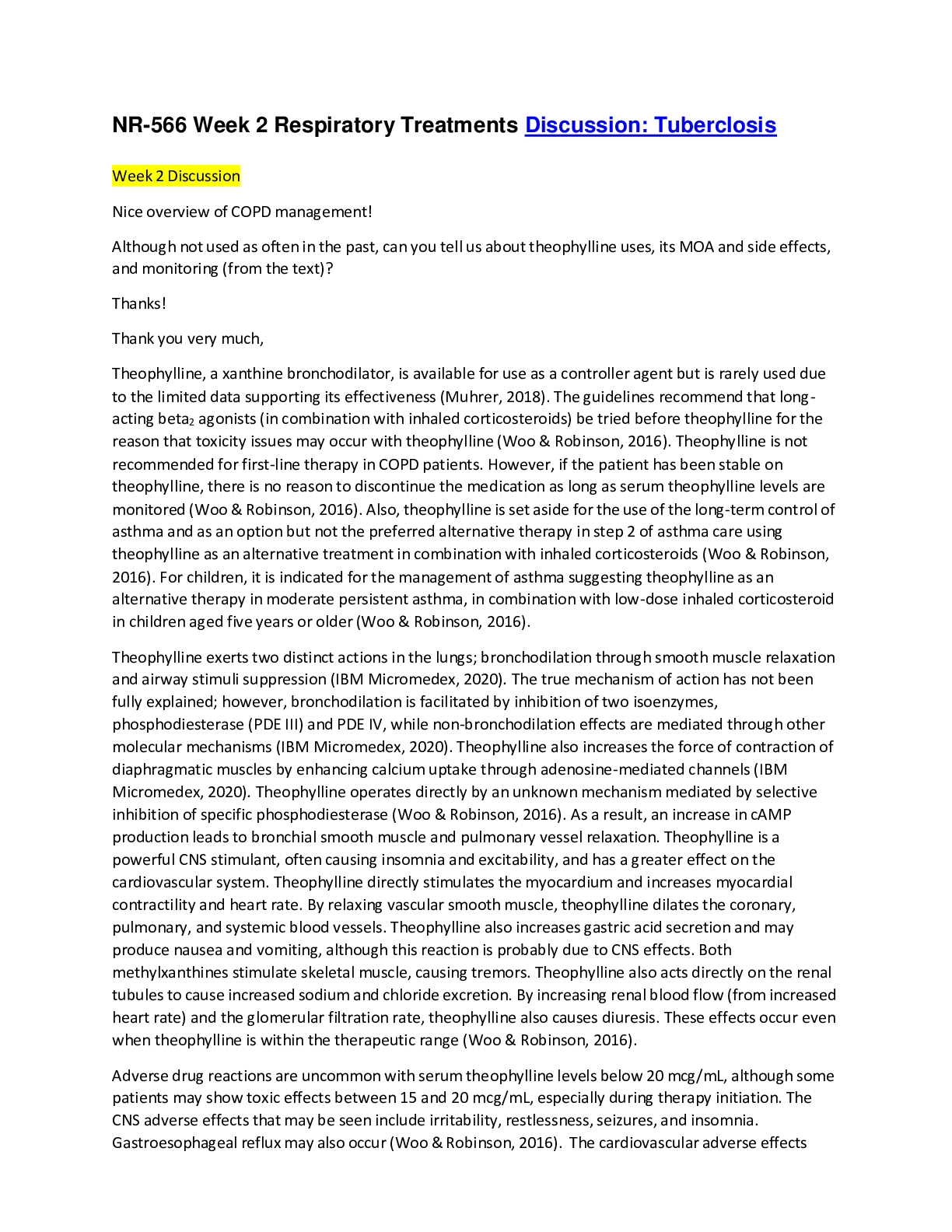
Reviews( 0 )
Document information
Connected school, study & course
About the document
Uploaded On
Jan 04, 2022
Number of pages
14
Written in
Additional information
This document has been written for:
Uploaded
Jan 04, 2022
Downloads
0
Views
81


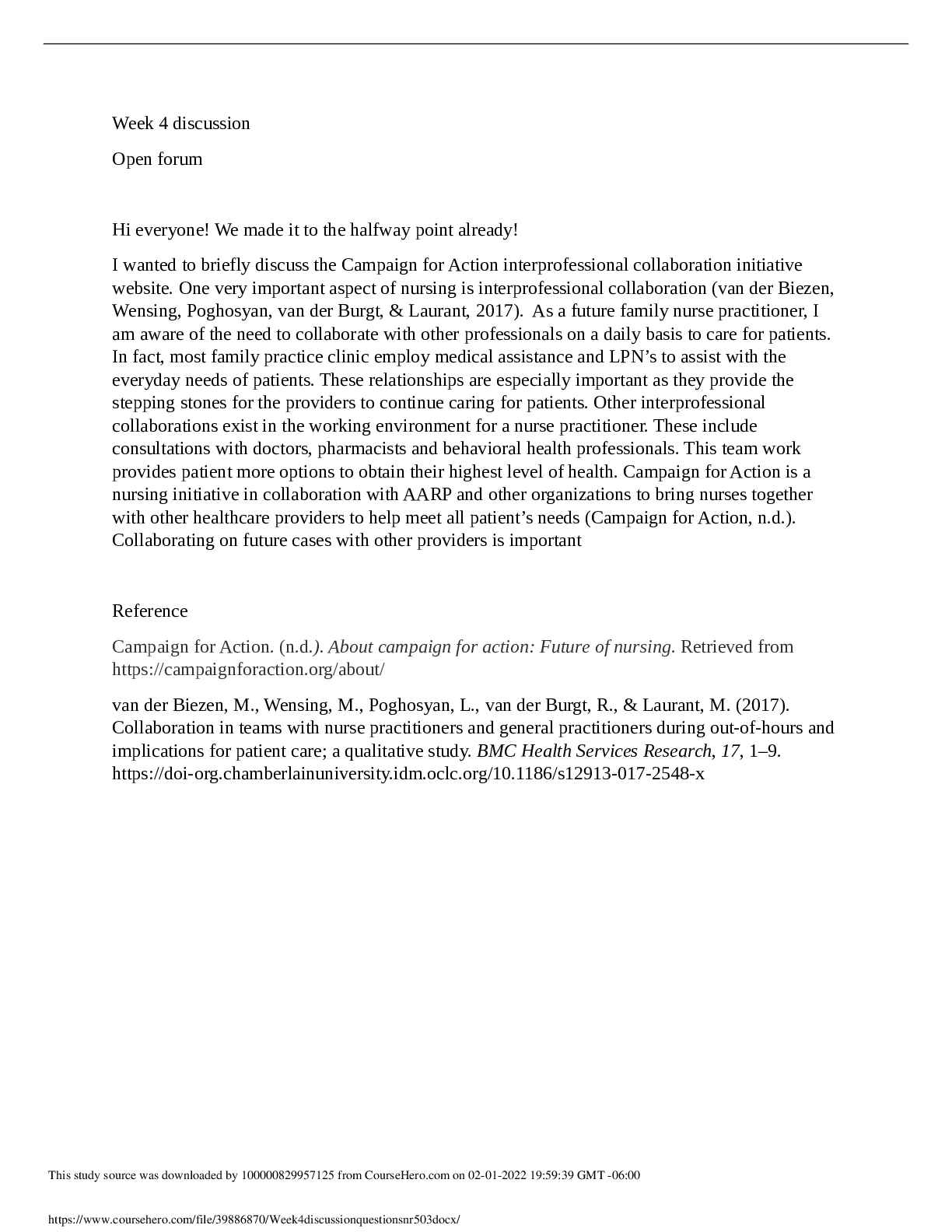

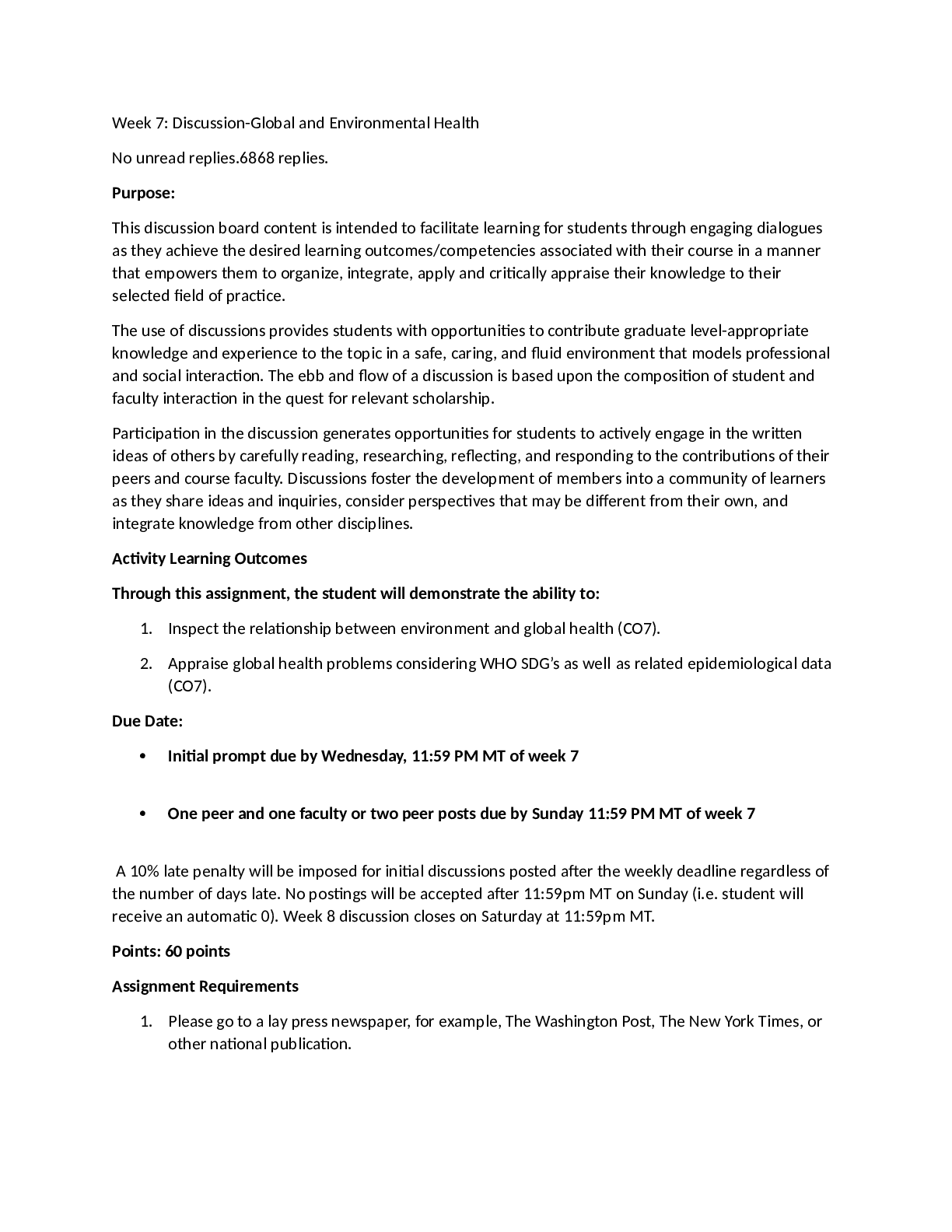


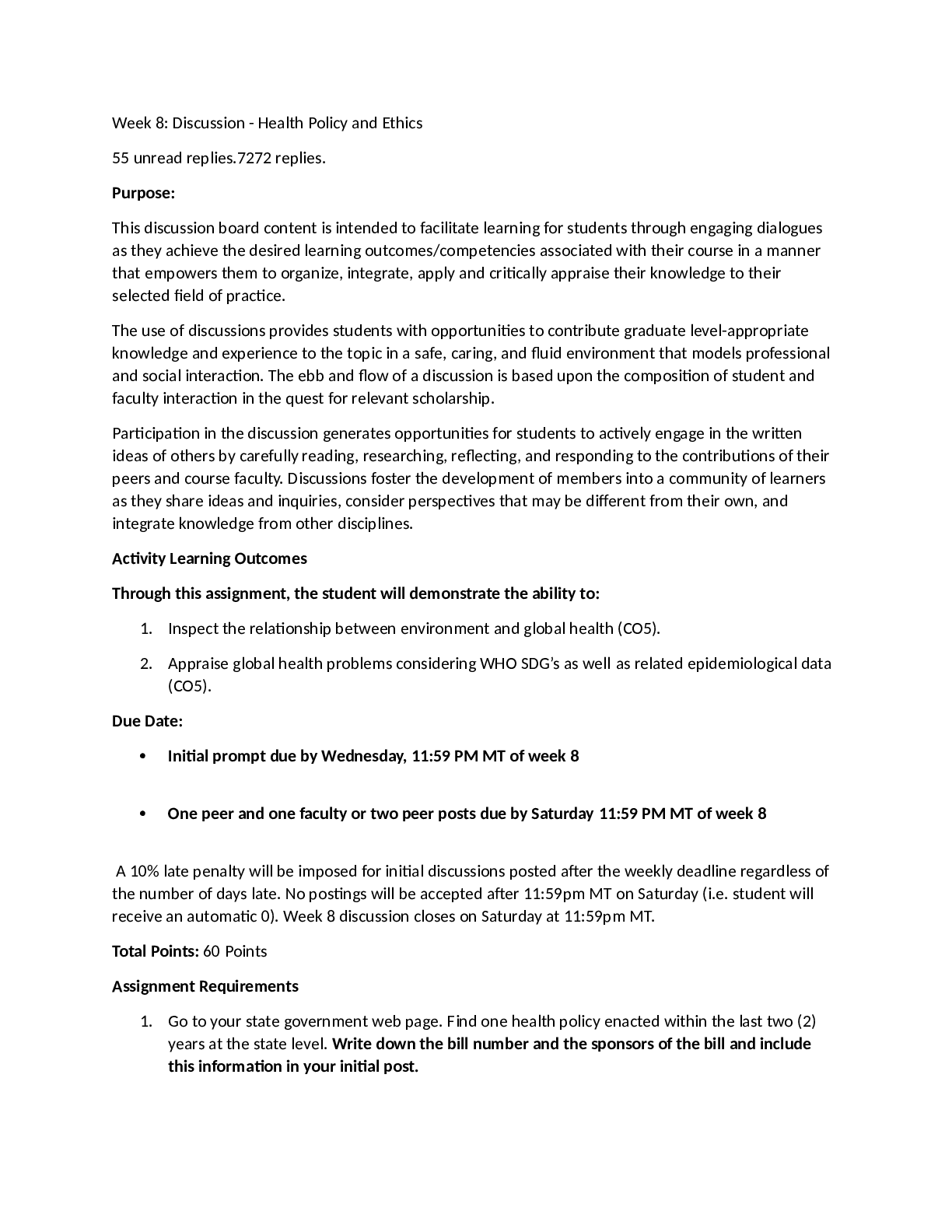

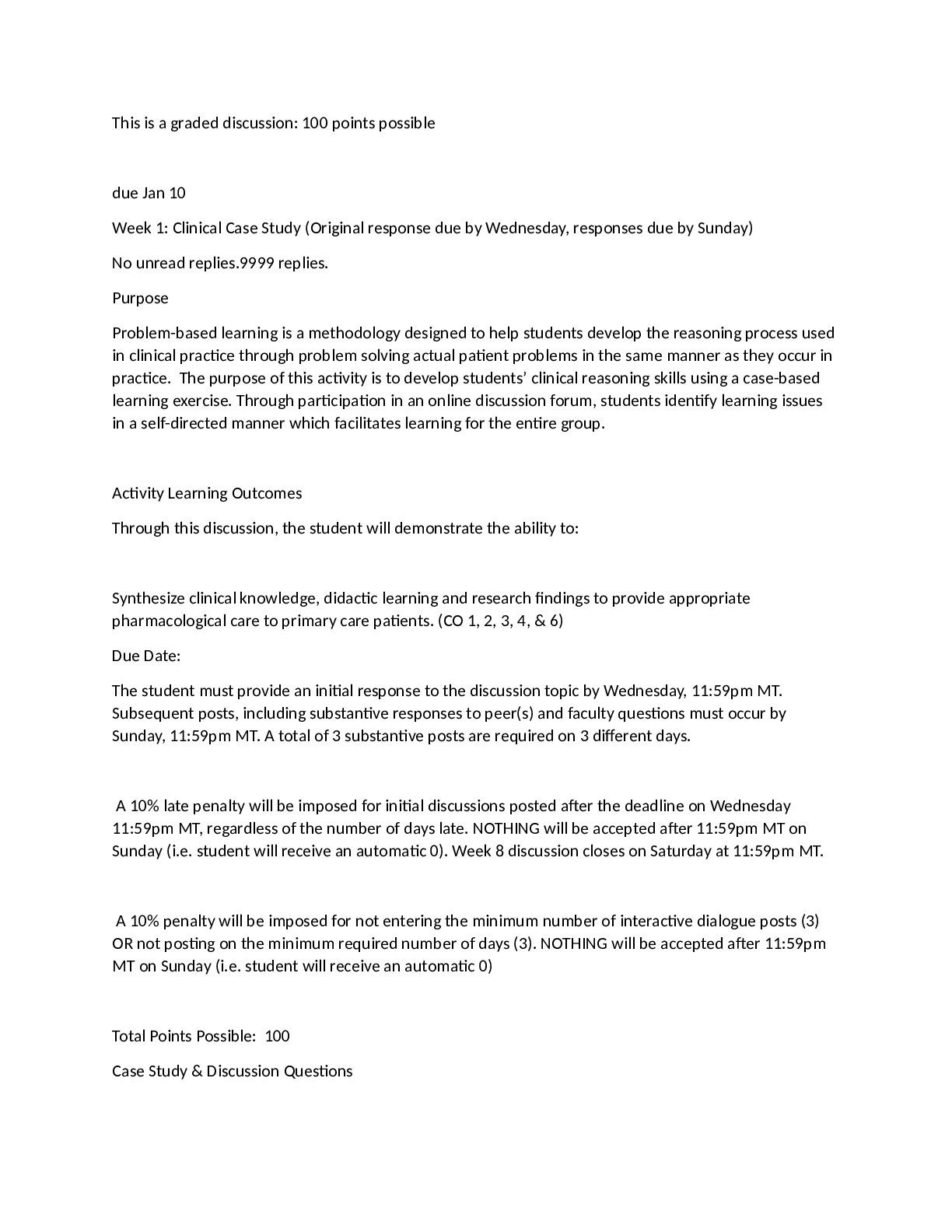
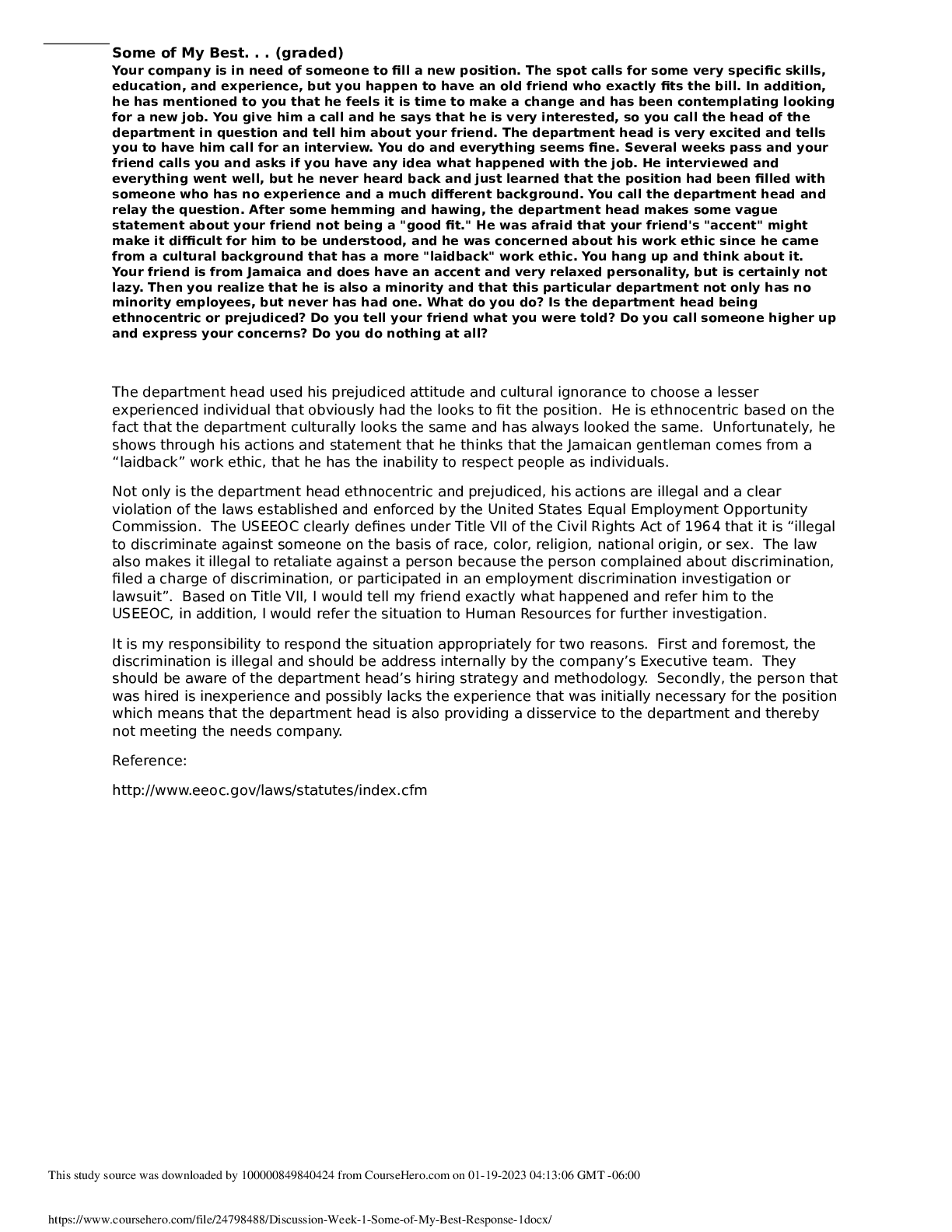


.png)
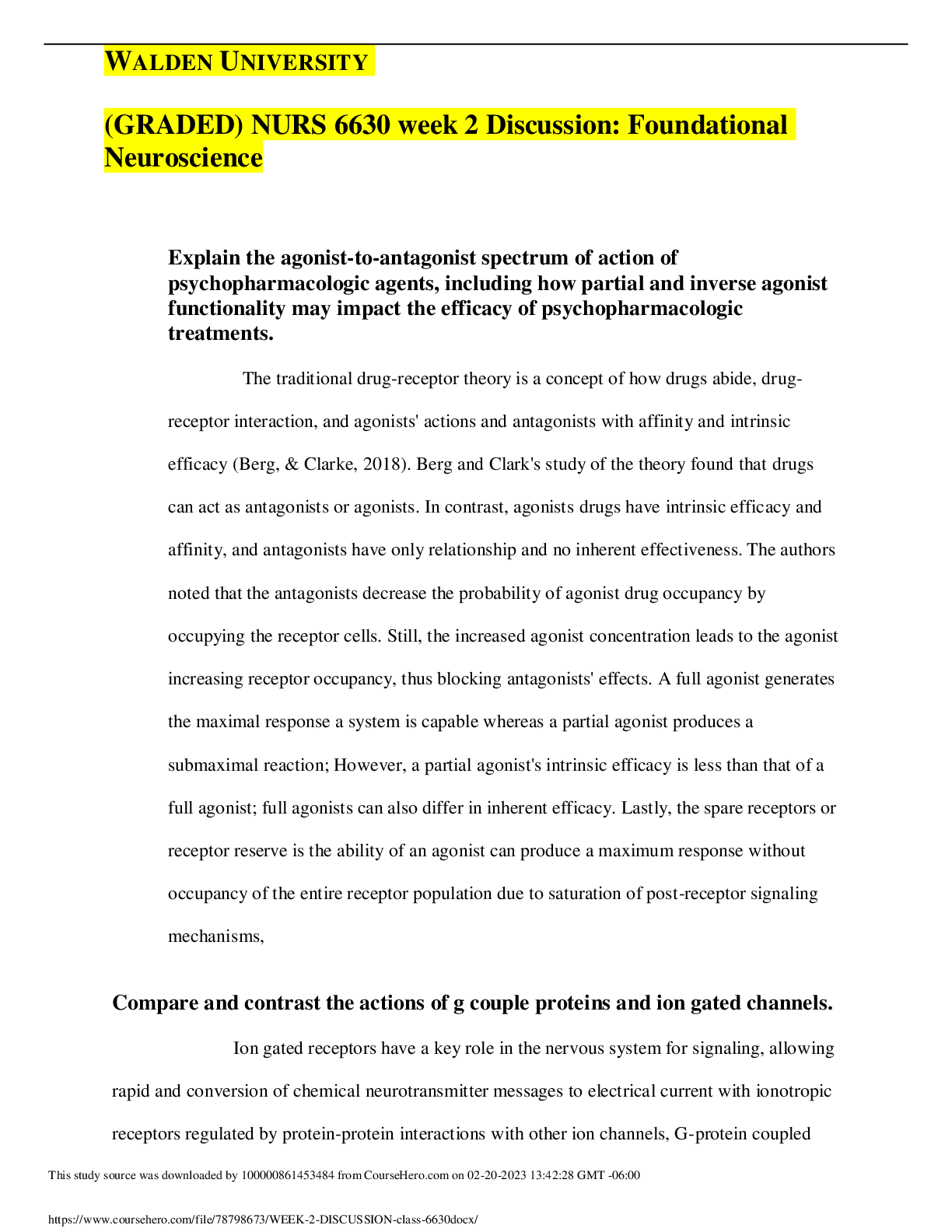

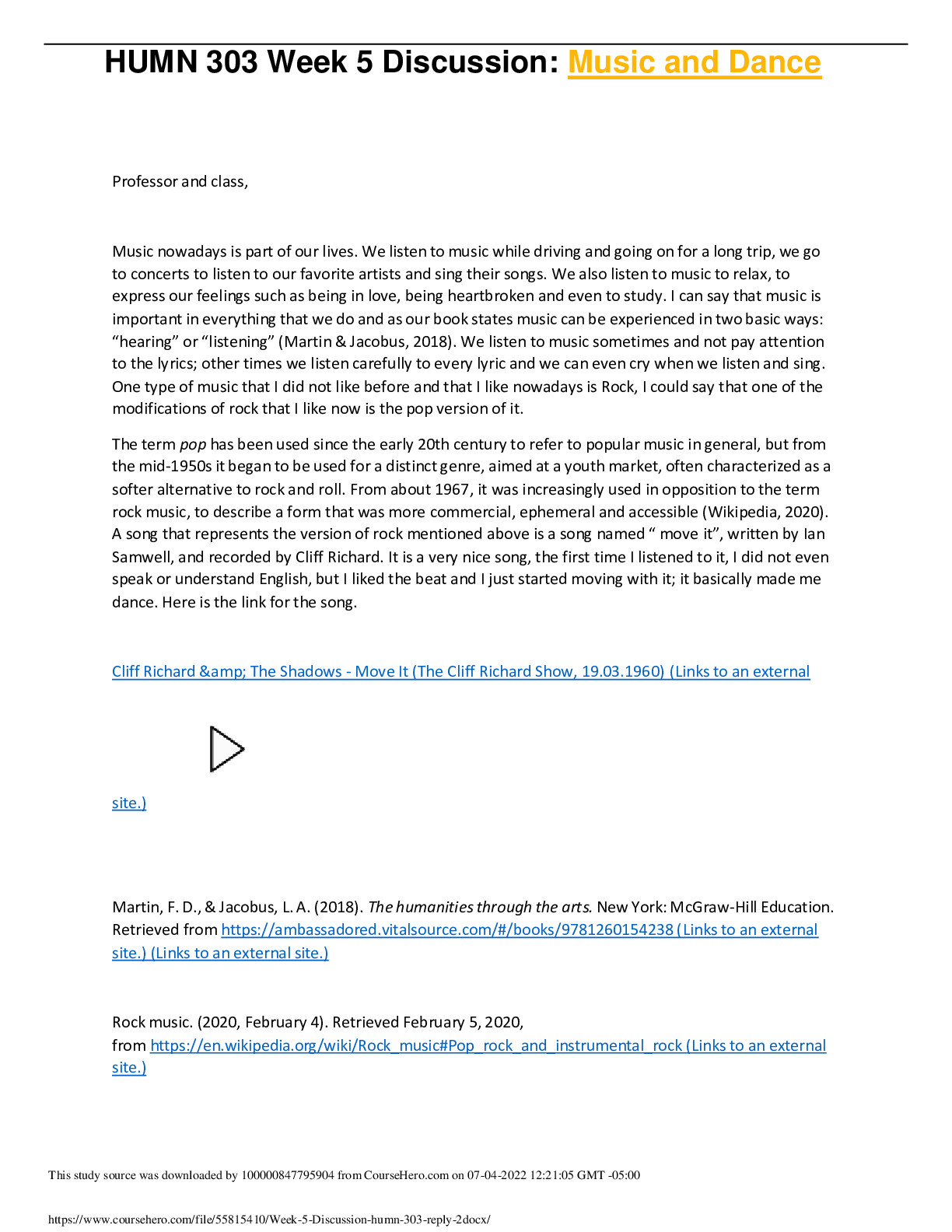
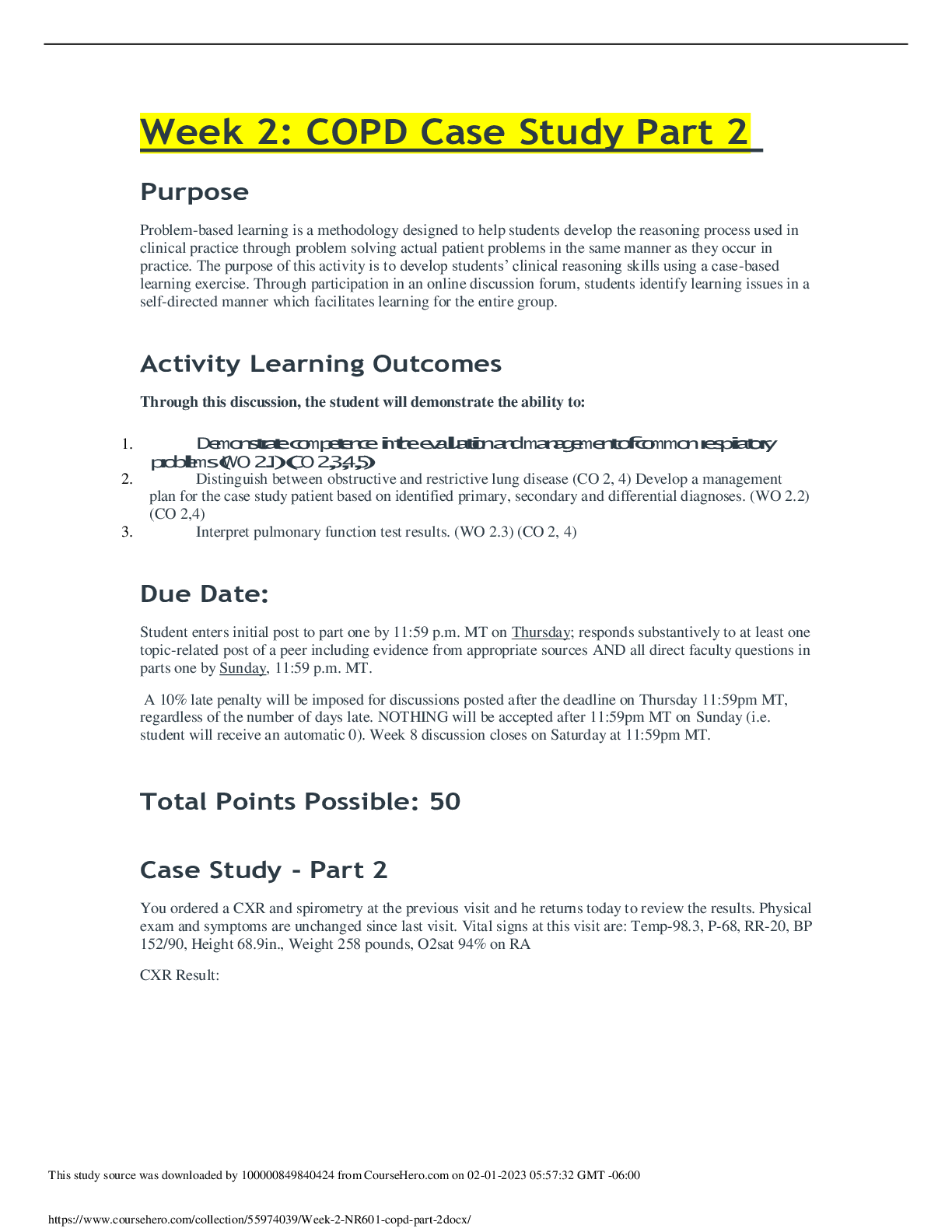
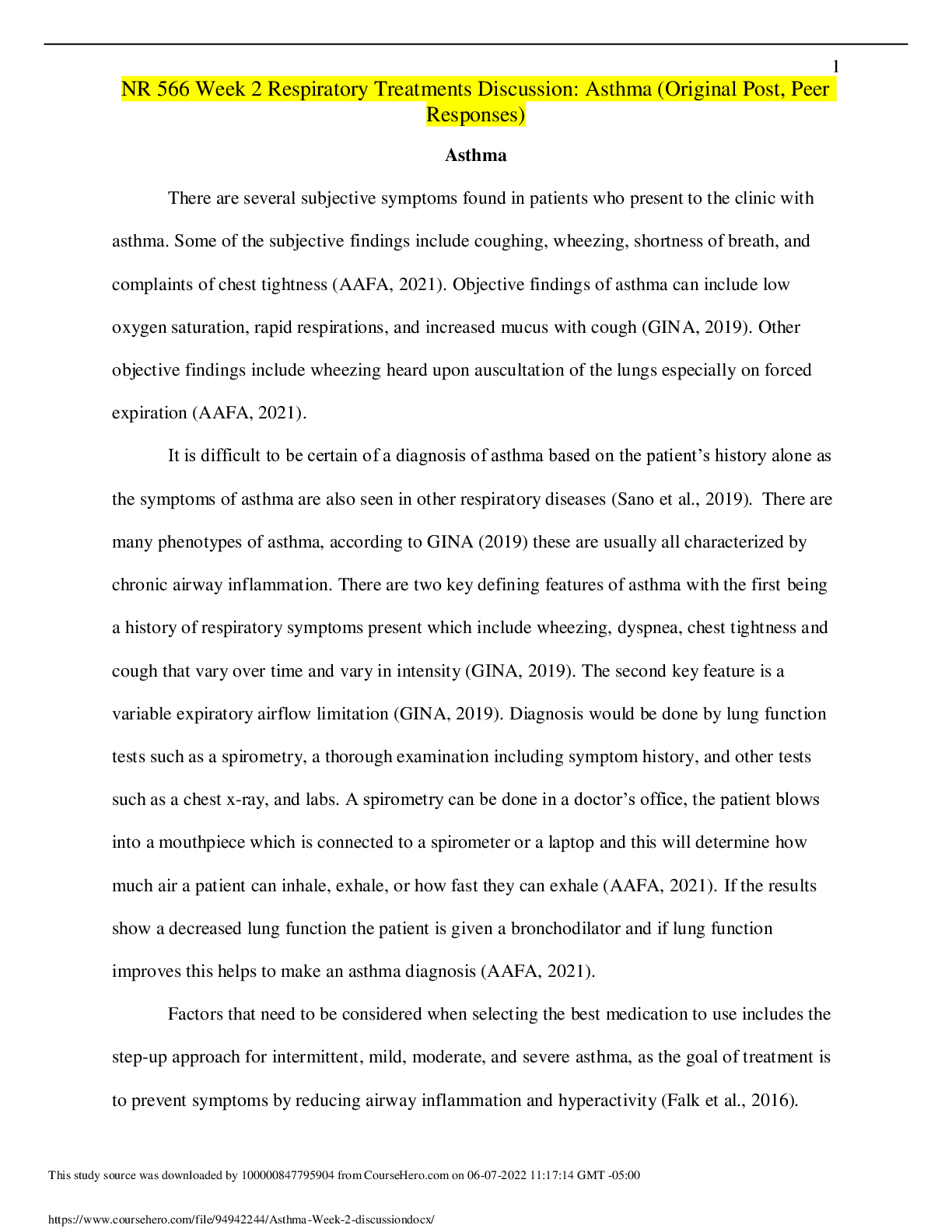
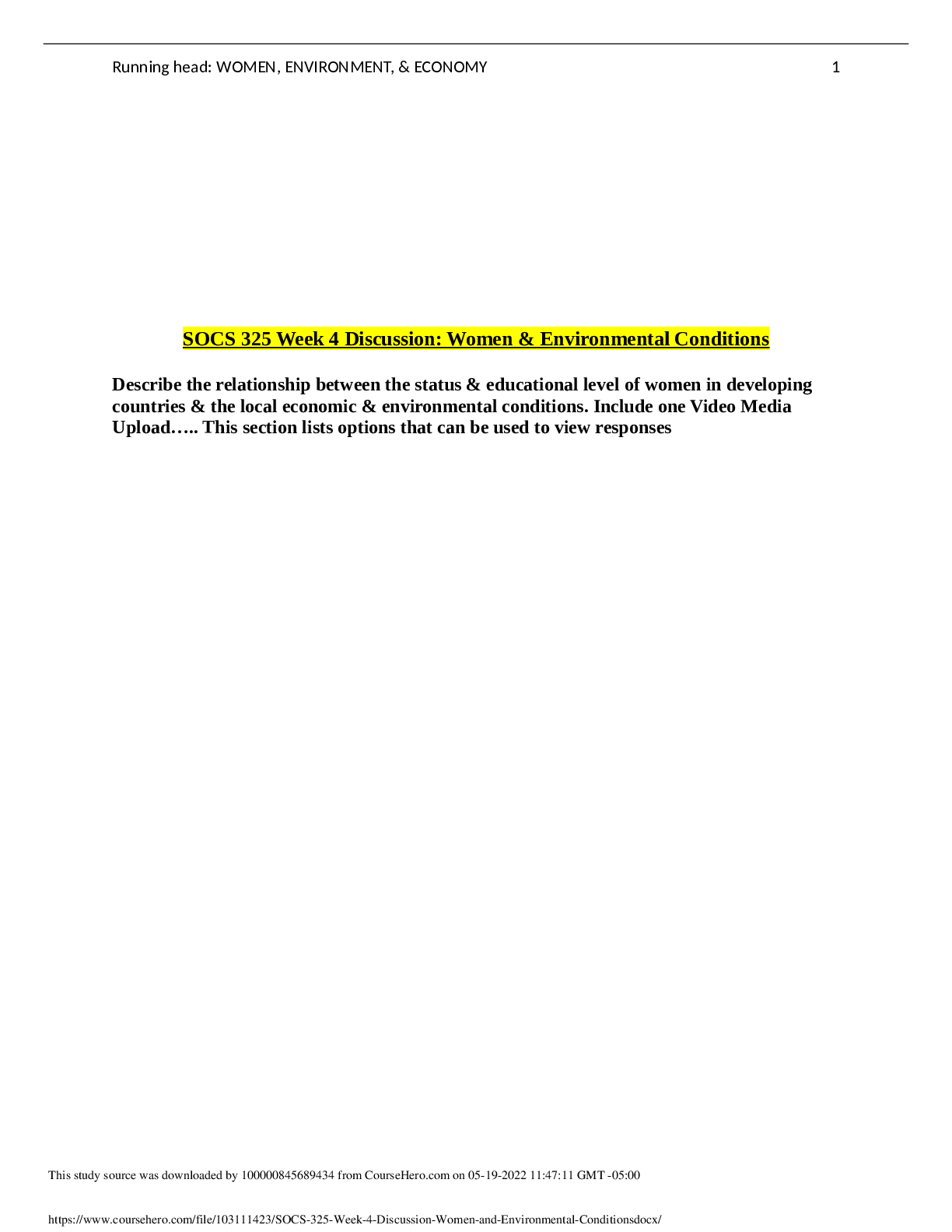

.png)
